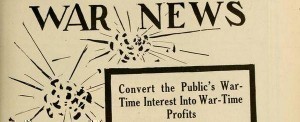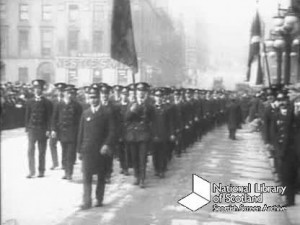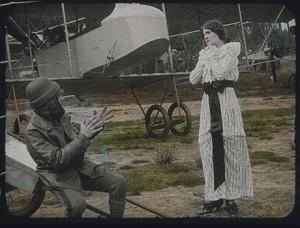Where are the images of First World War dissent in Scotland? Anti-war movements and the media, 1914-1918.
Written by Maria Antonia Velez-Serna, for Spirit of Revolt Archive, 2014.
“The fact that the peace movement survived at all in the face of massive government anti-German, pro-war propaganda and a vicious jingoistic pro-war press stands as testament to the tremendous courage and principles of all those involved”
John Couzin, Radical Glasgow, p. 88
Opposition to the First World War in Scotland had many different faces, but they all encountered similar hostility from the establishment media. The newspapers and film newsreels of the day, with very few exceptions, refused to cover anti-war protest, resistance and direct action. Other events, such as strikes and mutinies, were ignored or minimised by the media as they were considered detrimental to morale. To a certain extent, this was mandated by regulations in the Defence of the Realm Act which allowed the government to censor the press. However, direct censorship was rarely necessary, since the media were on board with the pro-war stance of their own accord. If nothing else, war sells newspapers. Because of this alignment between the British establishment and the press, we have few images and reports about anti-war resistance in Scotland, and therefore about a very important moment that brought together a number of radical struggles.  Image: Advertising for the Pathe Newsreel in the United States, Moving Picture World 29 August 1914.
Image: Advertising for the Pathe Newsreel in the United States, Moving Picture World 29 August 1914.
The first example of this media blackout has to do with the anti-war demonstration organised by the Independent Labour Party, the British Socialist Party and the Peace Society on the first Sunday after the declaration of war. As is well known, the ILP newspaper Forward claimed that 5000 people had listened to the speakers on Glasgow Green, in spite of a ‘boycott by the press‘. I have indeed been unable to find any newspaper reports of this event, and the newsreels at the time did not cover the event either. By the start of the war, most cinemas in Scotland included a newsreel in their programme – either the Pathé Gazette, the Gaumont Graphic, or the Topical Budget. These companies had reporters and equipment in Glasgow and often covered other events in the city; in the weeks leading up to the war, they had included topics such as the royal visit to Scotland, during which George V and Queen Mary visited Glasgow University and Beardmore’s shipyard in Dalmuir, where the battleship ‘Benbow’ was being built. This would remain a constant throughout the war – extensive reportage of royal visits while popular unrest was ignored.
Scottish readers and cinemagoers did get some glimpses of anti-war protest, however. The Stop the War demonstration held in London on 2 August 2014 was filmed by Gaumont, and included in the same issue of the newsreel that contained the Cabinet meeting and reactions to the declaration of war. The newspapers carried a report of anti-war strikes in Germany. These were presented as proof that Germany was disunited and weak. Furthermore, the fact that Socialists were involved in agitation in Germany was used to whip up reactionary sentiment: Socialists were debilitating the German war effort, and therefore Socialists at home could threaten the national interest. The contributors to Forward, perhaps surprisingly, agreed with this view, and saw the German strikes (including rent strikes) as a prelude to revolution. Soon afterwards they had to report on the severe repression that their German comrades suffered, even though information was hard to obtain. James Connolly, for instance, published a tribute to Karl Liebknecht, co-founder of the German Social Democratic Party and a conscientious objector, said to have been executed; this was not true (“A Martyr for Conscience Sake”, Forward, 22 August 1914). On the other hand, Forward accused the establishment press of whipping up war fever by fabricating ‘exciting’ naval battles and magnifying the atrocities perpetrated by German soldiers against civilians in Belgium and France.
 Film: The Glasgow Corporation tramway workers who enlisted to form the 15th Highland Light Infantry, marching past the City Chambers on 7 September 1914. At the Scottish Screen Archive Website.
Film: The Glasgow Corporation tramway workers who enlisted to form the 15th Highland Light Infantry, marching past the City Chambers on 7 September 1914. At the Scottish Screen Archive Website.
Not allowed to film at the front, the newsreels were hungry for images of war. The spectacle of military mobilisation at home had to take that place, and thus the films we have from that era consist mostly of an unrelenting succession of parades: the Territorials, the new recruits, the regular soldiers, all marching through villages and cities, going through their drills, getting on boats. These films were made for various reasons, not only propaganda; like many local films from before the war, they gave people a chance to see themselves and their neighbours on the screen of their local cinema. But their potential as a recruitment tool was recognised by the authorities. Many cinemas allowed recruiting officers to speak before the show, although the results were uneven: In August 1915, an officer from the Argyll and Sutherland Highlanders wrote to thank the manager of the Maryhill Picture House for allowing him to canvass there, admitting that “although the results at the time were not great, I hope it will have some effect on the many young men at present doing nothing for their country” (The Entertainer, 14 August 1915). The commercial cinema sector was mainly aligned and accepting of government rhetoric, in part due to fear of further intervention. But there were voices of dissent, as some members of the cinema trade had links with the left. The most striking case is that of Thomas Johnston, ILP councillor in Kirkintilloch and editor of Forward. Johnston set up a municipal cinema and opened it in November 1914 with a screening of The Curse of War (aka War is Hell), a pre-war Belgian pacifist film by Alfred Machin.
 Still from The Curse of War/War is Hell (Maudite Soit la Guerre, Alfred Machin, Belgium 1914)
Still from The Curse of War/War is Hell (Maudite Soit la Guerre, Alfred Machin, Belgium 1914)
It is worth drawing a distinction here between pacifist positions, like the one advocated by Machin’s film, and the stance taken by the ILP and more radical organisations, which was that of anti-militarism. While pacifism is against all violence, many Socialists and anarchists think that in certain cases violence may be the only way to bring down oppressive systems, for instance in anti-imperialist struggle and class war itself. As John Maclean put it in his article against conscription, published in December 1915,
“We Socialists, who believe that the only war worth fighting is the class war against robbery and slavery for the workers, do not mean to lay down our lives for British or any other capitalism […] They also had better not enlist us, for we will prove more dangerous with arms than without them.” (‘The conscription menace’, Vanguard December 1915)
Over the four years of war, opposition to the war took various shapes, in connection with ongoing struggles. On the industrial and syndicalist side, the takeover of several production plants for munition manufacturing was a step back for labour rights and for the work of radical shop stewards who had been advancing the idea of workers’ control. The engineers’ strike in early 1915 was the first significant moment, and again it was ignored by the newsreel cameras. The film trade, it seems, had little sympathy with the workers, with some exemptions. The local entertainment trade journal reported that, in Glasgow, “Considerable dissatisfaction in Cinema circles has been created by the action of a manager who gave ‘free’ Matinees to Engineers on Strike. We should have thought that Clydeside Engineers were making big enough wages to pay for their entertainments” (The Entertainer, 13 March 1915). Meanwhile, cinema managers spared no chance to boast of their generosity by giving free admission to soldiers, and took part in other war-related activities, such as raising money for Belgian aid (preferring to aid ‘Belgians in Belgium’ rather than refugees), promoting the sale of war bonds, and entertaining soldiers’ children. Considering that the cinema was a hugely popular working-class amusement in Scotland, it is significant (and disappointing) that the trade turned their back on the workers’ struggles. Similarly, although women formed the majority of the cinema audience, the suffrage campaigns were often ridiculed, women’s rights lampooned by the film industry, and Glasgow’s rent strikes went unrepresented despite taking place in parts of the city with a very high density of cinemas.
Industrial tensions reached a peak in 1915, when David Lloyd George, recently made Minister of Munitions, appointed William Weir as the Scottish director responsible for implementing the infamous Munitions Act. Weir was an industrialist notorious for his anti-union stance. Through his influence, the government tried to introduce ‘dilution of labour’, that is, the breakdown of production processes so that they could be done by unskilled workers and women. This represented a threat to wages and working conditions, but the main reason the shop stewards campaigned against it was that it was a top-down decision. Against dilution, and for the takeover of workplaces into workers’ control, the shop stewards organised successful strikes throughout 1915. Thus, on Christmas day, Lloyd George called a public meeting with the workers at the St Andrews’ Halls in central Glasgow, intended to cajole them into accepting dilution through sentimental, patriotic arguments. Although there were many disagreements between the different workplaces, the Clyde Workers’ Committee encouraged workers to attend, having been told that the Minister would take questions. As he kept speaking, members of the audience started to interrupt, and the meeting ended in disorder. Again, there are no extant moving images of Lloyd George’s visit that could have provided valuable historical evidence.
Unsurprisingly, the mainstream press reported that “the meeting was, on the whole, good humoured”, despite interruptions by Syndicalists and two verses of “The Red Flag” sung at the start (Scotsman, 27 December 1915). Forward, on the other hand, said that the crowd was “violently hostile”. Forward‘s report caused their offices to be raided and the issue to be seized by the censor, but it was reprinted in The Worker, the organ of the Clyde Workers’ Committee printed by the Socialist Labour Press in Glasgow. Both papers claimed that the official report of the meeting misrepresented what had happened. It made it look like the interrupters were callous men who did not care about their brothers at the front, when their rejection of the speaker’s sentimental appeals was simply a demand for concrete commitments and to be heard. This was not a vocally anti-war audience, although they denounced the profit motive behind the arms race, and expressed sympathy with Ramsay Macdonald, who had been a lone pacifist voice in Parliament. The workers were not against munitions manufacturing in itself, or against women in the workplace as has been said before. At a meeting with shop stewards at Beardmore’s Parkhead Forge (after the Fairfield workers refused to see him), Lloyd George was told that
“They, as Socialists, welcomed dilution of labour, which they regarded as the natural development in industrial conditions. They were not like the Luddites of another generation, who smashed the new machinery. But this scheme of dilution must be carried out under the control of the workers.” (Report from Forward reprinted in The Worker, 8 January 1916)
The Clydeside workers’ struggle in 1915 had thus been connected to the anti-war movement through the fact that war conditions were used to dismantle labour rights and restrict civil liberties, all in the service of capitalism at its most ruthless. As the year ended, an even more worrying development loomed. As William Gallacher wrote in The Worker, at this crucial moment, “the Cabinet decided to play their last and dirtiest card for the subjugation of Labour. Conscription!” The editor, JM Muir, argued that “The modified conscription measure now before Parliament is only the thin end of the wedge of industrial slavery – military control of the workshops.” (The Worker, 8 January 1916) Thus, at this point, the opposition to conscription was not, or at least not only, a pacifist stance, but it had to do with labour rights and the control of the means of production. The Military Service Act came into force on 2 March 1916 for unmarried men aged 18 to 41. Gallacher observed that the exemptions would help fracture resistance: “Of course, it is only the unmarried men they are after. This step is taken in the hope that the married men will play traitor to their fellows”. This became evident when the Act was extended to married men in May. The newsreels have images of the married men’s protests in London, which subtly planted a whiff of selfishness in their arguments, as they were said to demand that ‘unmarried men go first’. However, the fact that these men were not refusing outright made them still acceptable, in a way that conscientious objectors were not.
Film: Pathe Newsreel footage showing a London protest of married men against conscription.
https://www.youtube.com/watch?v=43y1bEiachg
By this time, the British state had started to realise the value of film as a medium for propaganda. Official cameramen had produced the startling images of The Battle of the Somme, a film that was seen by about half of the British population. Moreover, films were being used as a way to publicly shame those who refused to go to the front, with pressure from the community being a most effective way to force people to enlist. See for instance The call to the young, a film that presents older recruits as a way to shame younger men into joining up, and The woman’s portion, an extraordinary drama in which a young wife regrets having wished for the return of her partner, because he is now ostracised and disgraced as a deserter.
Film: The Woman’s Portion, 1918 official production
http://www.iwm.org.uk/embed/?id=1060023056&media_id=376332
This relentless propaganda, aimed at turning workers against each other, and getting civilians to police one another, makes the resistance by conscientious objectors all the more remarkable. Encompassing a wide range of opinions form religiously-inspired pacifism to anarchist refusal, the conscientious objectors were painted by papers like the Daily Express and the Daily Mail as traitors and spies. The appeal tribunals rejected most of the applications, mocking the applicants and asking disingenuous questions, such as ‘do you pay taxes?’ (if you do, you support the war effort), and ‘if you saw a wounded soldier lying on the ground, would you leave him?’ Against this hostility, the conscientious objectors still had significant support: crowds singing “The Red Flag” and cheering on the objectors were present at many courts. (Sunday Post, 19 March 1916) Again, none of this seems to have been captured on film – and nothing about the Women’s Peace Crusade that held a mass demonstration on Glasgow Green in June 1917. What did make it into the newsreels that summer was a nasty incident in which a meeting at the Brotherhood Hall in North London, which had long been a hub for anti-war activities, was attacked with the help and acquiescence of the police. John Maclean had been due to speak at the meeting, and other guests included Ethel Snowden (of the Women’s Peace Crusade) and the philosopher Bertrand Russell.
Film: Pathe newsreel footage showing a mob attacking a meeting at the Brotherhood Hall in North London.
https://www.youtube.com/watch?v=JPkOKOOcTkw
These brief images, captured on 28 July 1917, are a powerful illustration of the violence that pacifists endured, caused by the media spreading false rumours and by police complicity. The images and reports from events like this, as well as the prison letters written by many conscientious objectors, and detailed descriptions of labour camps such as the short-lived quarry in Dyce, Aberdeenshire, where Guy Aldred published the Granite Echo, dispel any doubt about these people’s courage and commitment. Although the numbers are not entirely clear, it is thought that throughout the First World War 16,500 men registered as conscientious objectors in the UK, 2425 of which were ‘absolutists’ who did not apply for exemptions and were sentenced to prison (Trevor Royle, Flowers of the Forest, p. 369) Apart from those who gave religious reasons, amongst the Scottish COs were many ILP members, but also some anarchists like Aldred, and countless anonymous radicals like the shipyard timekeeper who proclaimed “the sanctity of human life ‘neath the red flag of brotherhood” (Daily Record, 21 March 1916), or the Motherwell clerk whose exemption was rejected as the tribunal decided that “there is no conscience in Socialism”.
As the centenary of the war brings back to our screens all those images of soldiers marching, and whether the background music is mournful or jingoistic, it is worth remembering that there’s a crucial angle that the cameras didn’t cover at all, and that this lack of representation keeps happening because the mainstream media are still the mouthpiece of the ruling class. That’s why we need to open up the archives and dig out the stories that get buried under the yearly wave of red poppies.